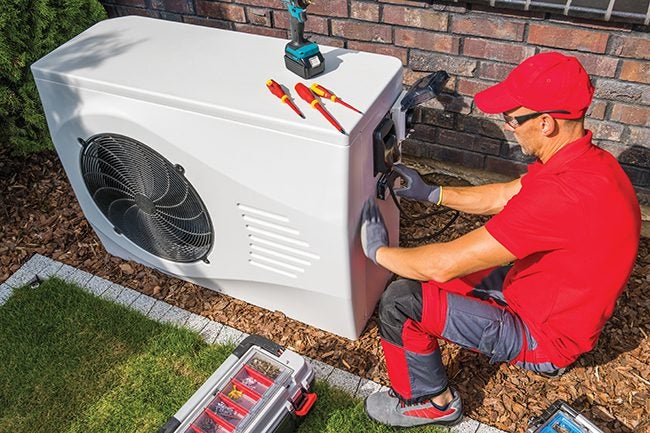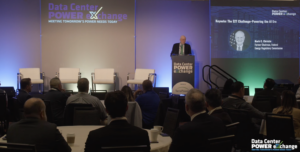A changing policy landscape presents challenges for moving away from fossil fuels. Executives say that may slow, but won’t halt, the momentum to electrify.
Remember the slogan “electrify everything”? It wasn’t that long ago when the push was on to replace technologies burning fossil fuels with electrically powered equivalents. Electric vehicles (EVs) would take over the roads from cars and trucks with internal combustion engines. That furnace burning natural gas in a home would be replaced with a heat pump (Figure 1). Neighborhoods and downtown business districts would be filled with all-electric homes and office buildings.
 |
|
1. Heat pumps are some of the best-known equipment for electrification, enabling homeowners to replace gas-powered furnaces and energy-intensive air conditioners. Heat pumps provide a more efficient way to heat and cool homes and businesses. Source: Envato Elements |
Electrification would be key for energy efficiency and decarbonization. Utilities offered rebates for energy-efficient appliances, states offered tax breaks for buying an EV, and some cities said they would ban or at least restrict the use of natural gas in new residential or commercial buildings. The International Energy Agency called electrification “one of the most important strategies for reducing CO2 [carbon dioxide] from energy.”
But then… that all-electric world met up with political reality. Governments backtracked on climate initiatives and energy-efficiency targets, many of which aligned with increased electrification. The Trump administration paused billions of dollars in funding for a nationwide network of fast chargers for EVs, money already allocated to states by Congress through the National Electric Vehicle Infrastructure (NEVI) program. Even before that order, some states pre-emptively said they would pause their participation in the program. Uncertainty about the future of federal (and perhaps state) tax credits for buying an EV, and the future of rebates for energy-efficiency appliances, threatens the electrification growth curve.
“In the current political climate in the U.S., a balanced approach that leverages both government policies and market forces is likely the most effective way to drive electrification,” said Coryn DeGrands, vice president of business development of energy at Bureau Veritas. “Government policies can create a supportive environment by providing incentives, regulations, and funding for electrification initiatives. However, market forces play a critical role in fostering innovation, competition, and scalability. Ideally, a synergistic relationship where government actions stimulate market adoption—while the market drives efficiency and cost reductions—could yield the most significant advancements in electrification.”
“If we look back at some of the most transformative technological changes of the past century, most have been driven by the private sector but enabled by a policy environment which did not restrict their growth,” said Joseph Vellone, CEO of ChargeScape, a global vehicle-grid integration platform. “For example, the discovery and production of new antibiotics was funded by five private pharmaceutical companies with market access granted by public health agencies. A more recent example is the widespread adoption of distributed solar power, which was driven largely by private R&D [research and development] but supported by public utility commissions that allowed households and businesses to export solar back to the grid.”
Vellone continued, “I think we’ve seen the private sector really step up to push electrification forward in the current political climate. For example, although the Department of Transportation has recently frozen NEVI funding, eight of the world’s largest automakers have committed to deploying 30,000 EV charging bays across the U.S. by 2030. Similarly, despite uncertainty as to the future of the EV tax credit, four of the world’s largest automakers have invested in a joint venture called ChargeScape, which unlocks thousands of dollars in cash incentives for EV drivers when they smart charge at home, effectively making up for much of what these drivers would have received from the EV tax credit.”
“I think government policies can accelerate adoption, but at the end of the day, market forces will drive the real, scalable change,” said Scott Macwilliam, founder and CEO of Kite Mobility. “So, while policies are helpful, I believe market-driven solutions will move faster than regulations. The key is to create models… that make financial, logistical, and environmental sense all at the same time.”
Dan O’Brien, senior vice president, Energy Solutions-Direct for DSD Renewables, told POWER: “Government policies currently play a role in making electrification more accessible, but market forces are already driving adoption and will continue to do so. Aside from the obvious environmental benefits of electrification, many businesses investing in solar, storage, and other renewable energy solutions are looking to them as a means to cut costs and protect against volatile energy prices. It’s a bonus that this approach also enables companies or municipalities to contribute sustainably, benefitting their operations and the impact on the surrounding community.”
‘Proven, Available Technologies’
Many technologies already are in place for electrification, as companies look at how to provide energy that’s more efficient and less costly. Paul Lambert, co-founder and CEO of Quilt, told POWER, “The key is starting with proven, available technologies that deliver immediate benefits. For heating and cooling, mini-split heat pumps are a perfect example—they’re incredibly efficient, provide both heating and cooling, and qualify for substantial rebates and incentives. At Quilt, we’re seeing that these solutions are being embraced because they’re an all-around upgrade compared to traditional systems—more precise control, more efficient, greater cost savings, and better comfort. These electrified systems aren’t just alternatives to fossil fuel systems, they’re superior in almost every way.”
“Accomplishing electrification goals with the right mix of technologies is particularly important for resilience, reducing the cost of local energy supplies, and in defining the new role of utilities in the emerging energy arena,” said Rinaldo S. Brutoco, founding president and CEO of the World Business Academy. “Municipalities should be taking the lead in these efforts by using fuel cell-assisted microgrids based on local renewable energy resources and supplemented by a hydrogen fuel cell. Having these safeguard technologies in place will ensure energy access for the times when ‘The wind don’t blow, and the sun don’t shine.’
“Clearly for direct energy supplies, the future is with localized distributed energy microgrids,” said Brutoco. “For individual homes, solar panels are a solution for providing reliable electrical supply. Paired with a backup storage system and a heat pump for cooling and heating requirements, individual homes would be more energy independent and resilient to the changing climate.”
 |
|
2. The new GE Vernova FLEXINVERTER manufacturing line is designed to produce both 1,500V and 2,000V FLEXINVERTER models, which the company said enable utilities to seamlessly connect renewable energy sources to the grid, ensuring stable and consistent energy supply for homes and businesses. Courtesy: GE Vernova |
GE Vernova in late January announced it would invest more than $10 million in a facility in Pittsburgh, Pennsylvania, to expand the capabilities of the company’s Electrification unit. The money will support a new manufacturing line for the company’s FLEXINVERTER product (Figure 2), which GE Vernova said is “a key technology for utility-scale solar and energy storage applications.” GE Vernova is launching a new Power Conversion & Storage business, one of three business segments within the Electrification division. The company said the move is in response to demand from customers for more power stability and energy storage solutions, tied to the rise of renewable power generation. It also noted the “continuous electrification of energy-intensive industries.”
“Expanding our Pittsburgh operations reflects our commitment to building a robust domestic supply chain for electrification technologies,” said Ed Torres, GE Vernova’s Power Conversion & Storage business leader. “This investment not only reinforces our role in supporting the energy transition but also aims to create jobs in the heart of the U.S. industrial base. As part of GE Vernova’s Electrification segment—our fastest-growing division with immense potential—Power Conversion & Storage expects to play a critical role in building the electrification backbone essential for achieving world climate goals.”
Siemens eMobility in mid-January said it has been selected as the technology partner for two major EV charging infrastructure projects in Italy. The group is partnering with Autolinee Toscane and IPLANET to drive the electrification of public transportation, and also support making fuel stations “into strategic service areas, further advancing sustainable mobility in the region.”
Siemens eMobility is electrifying multiple bus depots for Autolinee Toscane, a major public transport operator and part of RATP DEV Italia Group, in the cities of Florence, Prato, and Lucca, supporting the rollout of the company’s zero-emission bus fleet. The project will use Siemens’ vehicle battery charging infrastructure technology to support operations across Tuscany’s public transport network. It consists of a total of 73 SICHARGE UC charging points, capable of supplying 100 kW and 150 kW of power to charge EVs. Siemens also supplies medium- and low-voltage electrical distribution systems with switches equipped with Internet of Things (IoT) modules to ensure a transparent energy supply. Siemens eMobility also provides DepotFinity, a software platform for monitoring, reporting, programming, and managing charging operations within the depots.
 |
|
3. The IPLANET electric vehicle charging network includes hundreds of 300-kW to 400-kW charging points, all fully remotely monitored through independent connectivity channels. Courtesy: Siemens AG |
IPLANET, an energy transition solutions provider, has asked Siemens eMobility to equip more than 120 logistics sites (Figure 3) with advanced charging infrastructure. “Projects like these underscore Siemens eMobility’s mission to integrate sustainable mobility into everyday life. By combining cutting-edge technology and strong partnerships, we’re helping to transform the transportation and logistics sectors for a more sustainable future,” said Markus Mildner, CEO of Siemens eMobility.
Data and Digital Tech
Experts from Piclo, a UK-based decarbonization group, told POWER that electrification technologies “play a crucial role in enhancing grid flexibility and overall system reliability. By integrating distributed energy resources [DERs] like solar, wind, and batteries, utilities can better balance supply and demand and minimize infrastructure upgrades.” The group added, “Technologies such as grid automation, AI [artificial intelligence]-based forecasting, and real-time energy analytics help utilities anticipate fluctuations in energy production and consumption, which can then be combined with a marketplace to give even more options to maintain grid stability.”
“Data is the key—the grid needs both megawatts and megabytes to maintain reliability with increasing loads,” said Molly Jerrard, head of Flexibility, Enel North America. “Predictive and automated technologies inform energy users and grid operators to effectively integrate flexible loads. This also requires openness from utilities to share relevant data, especially to facilitate the growth of virtual power plants [VPPs].
“Electrification, when paired with flexible and digital technologies, can enhance grid stability rather than strain it,” said Jerrard. “Automated demand response and DERs allow utilities to shift flexible loads away from peak demand periods, reducing congestion and improving overall system reliability. Managed EV charging, smart thermostats, and AI-driven forecasting help balance electricity supply and demand in real time. VPPs can also help by aggregating and optimizing distributed energy assets, providing utilities with additional flexibility. By integrating electrification with data-driven solutions, utilities can turn new electric loads into an asset rather than a challenge.”
Electrification also is part of the equation for helping utilities manage electricity, and for flexibility of the power grid. O’Brien told POWER, “Leveraging renewable distributed generation like solar and storage can enhance grid flexibility by reducing peak demand and improving overall system efficiency and reliability. Battery storage is the key here, as it enables businesses to manage their usage and participate in demand response programs, shifting their energy consumption based on periods of high demand. By switching to batteries during these peaks, they can help reduce grid stress, and even supply energy back to the grid, further helping utilities balance supply and demand more effectively. Widespread EV charging infrastructure offers another important piece to the puzzle, especially as we see greater adoption of EVs and the potential for vehicle-to-grid charging capabilities in the near future.”
“What is actually driving electrification today is that it makes sense for everyone’s bottom line. The path of electrification mirrors other technological revolutions—costs decrease while performance improves,” said Lambert. “Unlike fossil fuels, which grow more expensive as supplies dwindle, electric technologies become more accessible and powerful over time. It’s the same pattern we saw with smartphones and computers—continuous innovation drives down costs while enhancing capabilities. Fossil fuels can’t match this trajectory of improvement—they’re limited by nature, while electric technologies are only limited by human ingenuity.”
“Strategic planning, technology adoption, and infrastructure modernization are all necessary to achieve electrification objectives. Entities should commence by conducting energy audits to determine the most feasible and advantageous areas for electrification,” said Kevin Gast, co-founder, chairman, and CEO of VVater, a water treatment group. “Heat pumps are a highly-efficient alternative to gas-fired systems in the heating and cooling industry, as they maintain performance while substantially reducing energy consumption. In industrial environments, thermal processes that are powered by fossil fuels can be replaced by electric furnaces, induction heating, and plasma-assisted processing. The transportation sector should prioritize the integration of charging infrastructure, the electrification of vehicle fleets, and the utilization of battery storage to optimize grid demand.
“In water treatment, substituting energy-intensive chemical processes with electrically driven purification technologies can significantly reduce energy consumption,” said Gast. “Smart grids, energy-efficient motors, and demand response systems should also be integrated to guarantee that the transition to electrification is effective and optimized for operational efficiency and cost reductions.”
‘A Combined Approach’
Several executives told POWER that to achieve electrification goals, entities should adopt a comprehensive approach that includes a combination of technologies and strategic investments. “In the current U.S. political landscape, achieving electrification cannot depend solely on market forces or government policies—it requires a combined approach where strategic government actions foster an environment for markets to flourish,” said Manav Mittal, senior engineering, procurement, and construction project manager for Ampirical, an engineering firm that works on power grid solutions.
“While innovation driven by the market has certainly propelled advancements in renewable energy, electric vehicles, and battery technology, relying only on market dynamics falls short in overcoming systemic obstacles,” said Mittal. “For example, private companies are unlikely to invest in comprehensive nationwide EV charging networks or modernizing the grid without some form of incentives, and sectors like green hydrogen encounter a ‘chicken-and-egg’ dilemma where costs won’t decrease without initial public funding.
“Additionally, fossil fuel infrastructure remains deeply rooted due to years of subsidies and regulatory inertia, which market forces alone cannot dismantle,” said Mittal. “Even in a politically divided environment, government policies are crucial to rectify these market failures. Tax credits, grants, and regulations such as emissions standards offer certainty for private investments—illustrated by the expansion of Tesla and the renewable energy sector following federal support. Effective policies that utilize market dynamics to promote public benefits—such as clean air, climate stability, and equitable access—are not only essential but also attainable, even in today’s divided environment. The U.S. does not have to choose between government intervention and market forces; instead, it should adopt approaches that capitalize on the strengths of both.”
Lambert said that even amid challenges to adoption, “Electrification represents the next great energy transition in human progress. Just as society evolved from burning wood, to coal, to gas, we’re now moving to electricity. This isn’t just about decarbonization—it’s about advancing how we power our lives. When businesses and municipalities adopt smart electric systems, they’re participating in this historic shift while gaining more intelligent, responsive infrastructure. Like the transition from flip phones to smartphones, the benefits are transformative.”
—Darrell Proctor is a senior editor for POWER.











